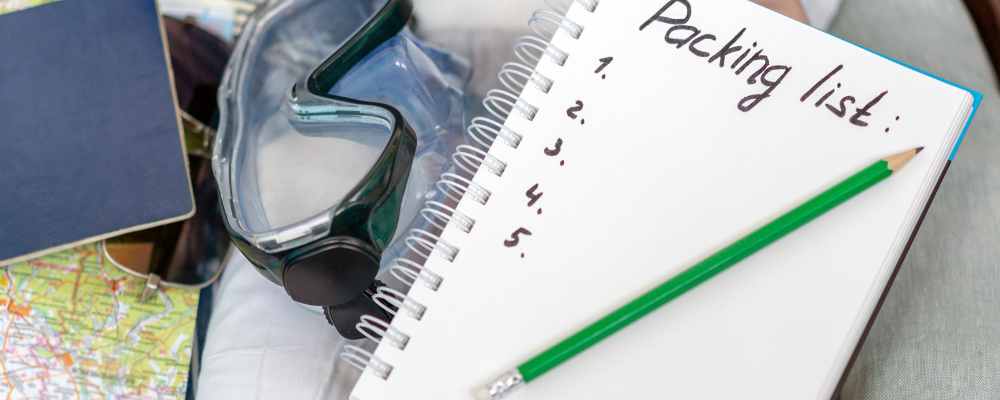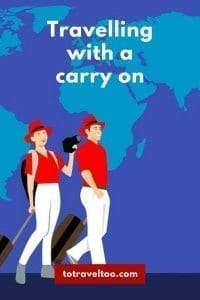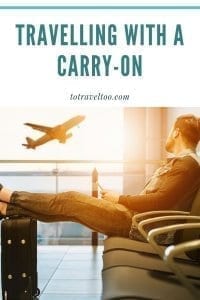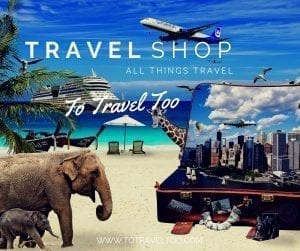Wondering how to travel with a carry-on only?
We have been on the road since 2013. We have packed too much, carried too much, and paid many $$$ sending ‘stuff home’. Enough is enough. We were fed up with lugging heavy bags into taxis, buses, boats, ferries and the worse tuk-tuks. But we had to go through the pain!
Our lifestyle is now minimalistic so our travel style should represent the same. We have said goodbye to heavy suitcases and now have a lighter load to carry which makes it so easy to traverse from airports to train stations to bus stations and many other forms of transport along the way. We learned the hard way though! Carry-on luggage is the way for us to travel now.
This post may contain affiliate links. Please see our disclosure for more information. As an Amazon Associate, we earn from qualifying purchases (if applicable).
We had three years of pain from 2013 to 2016 before we saw the light.
In 2016 we undertook a lot of research, we read reviews of carry-ons, and we looked at their durability and sizes. We came up with our list of pros and cons for using a carry-on.

Pros:
- No baggage fees
- No bag drop when checking in
- No waiting time at the luggage carousel
- No concerns about damaged or lost luggage
- Savings on cab fares, we can either walk or take a bus
- A lot safer as any potential thief can see we only have a small amount
- No more damaged TSA locks
Cons:
- Longer security checks
- Size limits on toiletries
- No scissors
- Different carriers with different carry-on size restrictions
What we required in a carry-on
- Material that was durable for the amount of travelling we were doing
- Functionality – storage options
- Size
- Good reviews
- Luggage that could stand up on its own
- Strong wheels
- Lightweight frame
- Total weight no more than 2kg
Travel tips:
Many travellers we spoke to gave us a great tip, check the airlines that you are travelling with and then purchase a carry-on that suited that airline’s recommended maximum size. We do note that many budget airlines have stricter regulations such as size, weight and quantity. Our choice of carry-on is based on our past international airline usage.
Osprey Carry On – 46 Litre was the winner
Since 2016 our Osprey carry-on luggage and day packs have travelled the world with us and they are all still going strong.
We highly recommend them for their toughness and durability. They have been thrown around by baggage handlers, stuffed into buses, thrown into ferries and are still living to tell the tale.
We passed our 46L onto our children and now we are travelling with the Osprey 40 l Wheeled Travel Pack. This is different from the 46L as it has a backpack suspension, which we removed as we didn’t need it.


- Premium efficiency and design
- Storage tuned to the each season
- Purpose designed to help mak the most of each exploration
- Designated laptop sleeve fits up to most 16″ laptops
- Travel Sentry Luggage ID helps make sure your pack doesn’t get lost along the way
- High-strength YKK Racquet Coil Zippers for durability and confidence
- Organizer pocket with key clip and padded electronics/glasses pocket
- Hidden Cash Stash pocket to safely secure travel essentials
Hand Held Luggage Scales
We now carry with us hand-held luggage scales. 1. to check whether our luggage has increased in weight and 2. as a backup if our carry-on weight is questioned.
Packing Cubes – Yes or No

A definite yes! Packing cubes have been a game changer.
We travel with 4 luggage packing cubes each. These were given to us when we attended a travel conference.
The largest packing cube we use for shoes, and two medium-sized cubes are for shorts, trousers, t-shirts and dresses. The smaller one is used for underwear and socks.
Purchase them below:
Day Packs
Now, what about a carry-on day pack for our technology? Back in 2016 we looked at both the Osprey Travel Backpack and the Osprey Day Pack. The Osprey Day Pack was suitable for carrying our electronic equipment. It was sturdy, and practical with also pockets for a drink bottle and umbrella.
We still have our original Osprey Day Pack that we started out in 2016 using.
That model has been superseded, check out the latest models below.
Osprey Day Pack
Between us in our Day Packs we carry:
Business Cards
Electrical Power Board
Travel Adaptor
Apple Macbook Pro
MacBook Air
Hard drive
Chargers
Water Bottle
Passport, travel documents, wallet
Camera and mobile phones
Packing List for Carry-On Luggage
We tend to overpack when we travel. Here are some of our top tips to help you pack all that you need in your carry-on luggage.
- Wear your heaviest clothes on you on the flight e.g. trainers or sneakers, jacket (it does get chilly on the plane), scarf
- Instead of taking a handbag wear your money belt on you (if you do need a handbag for a special occasion take a small flat one that does not weigh much or take up too much space)
- If you usually take books with you to read on the plane download them to your mobile phone
- Take ear pods with you instead of large headphones that will take up space.
- Take a small first aid kit with you.

Female Packing List
- 1 long-sleeve shirt
- 3 t-shirts
- 1 pair shorts
- 1 pair of casual trousers
- 1 rain jacket or down jacket
- 1 hat
- 1 pair sunglasses
- reading glasses
- hearing aids with batteries
- 1 dress
- 1 shawl
- 1 pair swimmers
- 3 pairs underwear (pants and bras)
- 3 pairs socks
- 1 set pjs
- 2 pairs of shoes (apart from your heaviest ones that you wear on board, pair thongs and a good pair to go with your clothes if you are going out)
Toiletries

These days most hotels and holiday rentals provide shampoo and conditioner. If they don’t you get buy small bottles locally on arrival.
- deodorant
- sunscreen
- eyeshadow, blush and lip all in one container (tip: make sure the container is sturdy enough that it does not break in transit)
- mascara, eyeliner
- makeup removal pads, moisturisers
- razor, toothbrush, toothpaste, emery board
- brush and comb
tip: I place all of these in clear sealable bags so they are clearly seen through the imaging machines
Male Packing List
- long sleeve shirt
- 3 t-shirts
- 1 pair shorts
- 1 pair long trousers
- 3 sets underwear
- 3 pairs socks
- 1 rain or down jacket
- 1 pair sunglasses
- reading glasses
- hearing aids and batteries
- 1 hat
Travel Insurance
We recommend taking out travel insurance as soon as you book your flights and pay deposits on any cruises, tours or hotels. Travel insurance offers protection when things go wrong before or during your travels, that is why we highly recommend that you take out travel insurance.
Final words on how to travel with a carry-on.
We hope you have enjoyed our article on how to travel with carry-on luggage. Once you have tried it once you won’t want to go back to lugging heavy suitcases around. Let us know if you have tried it and what you thought of it.
If you like our article why not PIN it for later:
Check Out Our New Travel Shop on Amazon
We are grateful to be able to be of service to you and bring your stories that we hope you enjoy. In this article, we have used affiliate links on where to purchase the luggage that we are travelling with this year. When you click on an affiliate link we are paid a small commission that helps keeps us travelling and bringing you stories.





Hi guys have been reading a bit of your blog and just read this one about travelling with your Osprey carry on. My hubby and I are setting off indefinitely next March to travel Asia and I was looking at the exact same option as you the Osprey 46 and backpacks but have read some not so good comments on the handle and materials not lasting the distance and not being strong enough. Any thoughts as yet as we are going to purchase our luggage soon to try out on a few smaller trips. I will most likely go with this option or the Osprey Meridian but not carry on size.
Hi Nicole
Thanks for reaching out re the Osprey. We chatted with alot of travel bloggers and Osprey was the favourite. We have been on the road now for a month and have had no problems at all, better than our previous brand Denali we used (failed first flight). We will be on the road for about 18 months so it was important for us to have something that will last. We will keep updating our readers on how the bags are handling continous travel. Hope this helps! Travelling with this size has definitely made it easier for us to get around.
regards Jane and Duncan
Hi Jane and Duncan
I was wondering how you get around the 7kg carry on limit that some airlines adhere to. I know your Osprey bag would be within the dimensional limits but I am sure I could not pack within the weight.
Regards
Sharon
Hi Sharon
Thanks for your comments. Qantas did not worry about the weight of the carry-on, but Swiss Air did so we had to check it in there. We are travelling with between 9 and 10 kg, we could actually wear a bit more clothes when flying to reduce the weight. Our flight to Stockholm, we checked the bags in as we had purchased Vodka to drink whilst in Stockholm, it is so expensive over there to have a drink. What was interesting was that we flew Vueling from Barcelona to Stockholm and we were not allowed to put our day packs above our seats – apparently Vueling’s rules states that the overhead lockers are for only carry-on luggage and our day packs had to be under the seat in front of us. Guess we will just go with the flow with all the carriers we are using as we travel around, checking all the time and wearing more than what we need to! Cheers
Hi Jane and Duncan:
Really enjoyed spending time with you at TBEX Stockholm.
Great article – Penny and I have a lot to learn from you guys in terms of packing – starting with light weight bags certainly help – our current suitcases empty weigh in at just over 7lbs (3.2kg).
I do have some questions about definitions – of course you are using Aussie terminology that needs translating for the US market:
What are swimmers?
Turkish Towel – is this just a regular towel (if so, what size) or is there some significance to the “turkish”
Havianas ??!!
Define “jumper” and “thongs” – in the US the latter are in the singular and refer to VERY skimpy underwear (hence the term “don’t get your thong in a wad”) – is that what this is or something else?
What do you mean by an electrical power board – is that a voltage converter or something else?
Do you each carry laptop chargers, iPad chargers etc or do you share any chargers you carry? No mention of a charger for your camera or extra batteries – oversight or …..? What about a flashlight?
Curious why you need 4 iPhones plus an Android phone since I thought you told us you only use phones on WiFi. When we are in a single country for several weeks we use a SIM for that specific country and both have voice and data so that if we are apart we can communicate with each other as well as locals that we meet.
When we are touring we have found that having a data plan on one phone (Penny) and a voice and data plan on the other phone allows to have easy local communication plus mapping capabilities while out and about. Our most recent foray into Europe we had a UK phone number but with a special access code (bridge) so that we could make inexpensive calls to anywhere in Europe plus the USA. Cost for the voice SIM was about US$60 per month including unlimited data and the data plan alone was 3gig valid for up to 3 months for US$40.